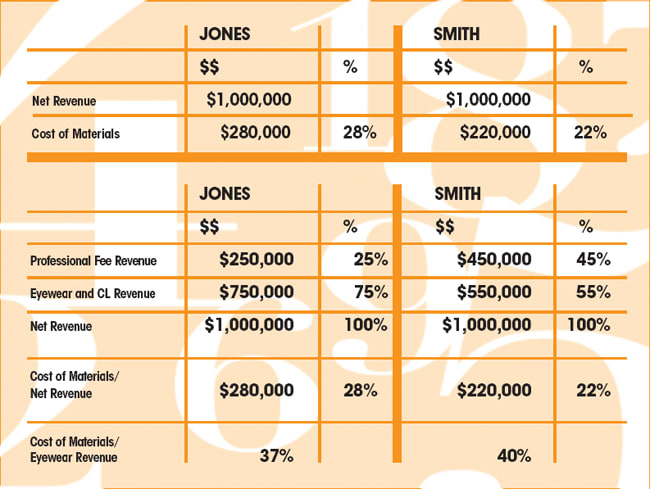eyecare by the numbers
A Misleading Number
Al Cleinman
Cost of Materials (or Cost of Goods) is one of your most significant expense areas. The ratio, which is depicted as a percentage, is most often calculated by dividing materials costs by total revenue.
In the old days, optometric businesses were considered healthy if this number were 33 percent or less. Times have changed.
We often compare this number with others, as if having a low cost of goods ratio a kind of badge of honor. The reality is that if you've seen one Cost of Goods ratio then you've seen just that…one Cost of Goods ratio.
Indeed, in today's more medical world, the Cost of Goods ratio can be very misleading. I have witnessed many bad decisions made because ECPs looked at this number in the wrong way. It is virtually impossible to gain any kind of knowledge from simply comparing this ratio with peers.
QUESTIONING YOUR NUMBERS
There are other reasons why your current Cost of Materials ratio could be misleading and even guiding you to make poor business decisions.
■ ARE YOU USING PROPER ACCOUNTING METHODS? Most ECPs operate their business using Cash Basis Accounting.
For many reasons this is a mistake. If you're not operating your business using Accrual Accounting (recording income and expenses as incurred vs. when received or paid), among other issues, you are likely measuring your Cost of Purchases and not true Cost of Materials.
Especially as it relates to frames, what you buy is NOT what you sell. If inventories swell, under Cash Basis Accounting, what you're recording as increased Cost of Materials is actually an investment in inventory.
While increasing inventory consumes cash and incurs carrying costs (the interest on the money tied up in inventory), inventory is an asset, not an expense. Inventory purchases have little to do with Cost of Materials.
■ ARE YOU PROPERLY RECORDING SHIPPING COSTS? Many ECPs record their costs for shipping materials as a freight or postage cost and don't include this in Cost of Materials (it's shown under general expenses on your Income Statement). While you should track this number separately, it should be a sub-category of Cost of Materials.
■ ARE YOU APPROPRIATELY RECORDING LABOR COSTS? The labor costs associated with producing eyewear (lab labor) should be recorded as part of Cost of Materials. As with shipping costs, this number should be maintained in a subcategory.
■ WHAT ABOUT EQUIPMENT LEASES? Often, equipment leases and maintenance costs are grouped into a single category, regardless of the type of equipment.
If your practice leases lens fabrication equipment, this cost should be recorded as a subcategory of Cost of Materials.
■ WHERE DO YOU RECORD FRANCHISE FEES? Some ECPs belong to buying groups or other entities that charge a fee for participation. These are often misrecorded as dues or professional fees. If your involvement with these organizations is predominantly for the purpose of purchasing, these fees should be recorded as a subcategory of Cost of Materials.
■ DO YOU RECEIVE REBATES? Some purchasing arrangements involve rebates or other income that is paid directly to the ECP from a manufacturer, based on that ECP's purchases. We often find this income recorded as Revenue when, in fact, these payments are actually a reduction in Cost of Materials and should be recorded as such.
ACTION PLAN
Given the dynamic nature of our industry and the degree of competition at all levels, it is appropriate to focus energy on reducing Cost of Materials (increasing margins). Since every practice has a unique revenue mix, however, Cost of Materials can be a very misleading number; one difficult to compare, practice to practice.
■ ACTION. As the saying goes, “Garbage in, garbage out.” During the next quarter, focus your attention on ensuring that your practice is properly accounting for materials costs. Begin tracking your true Cost of Materials against Eyewear Revenue vs. Total Revenue. Once you have the right information and can begin comparing period to period, the numbers will start talking to you. And, you'll be better prepared to look for improvement strategies. EB
Alan Cleinman is the founder and CEO of Cleinman Performance Partners (www.cleinman.com), a business consultancy specializing in the development of high performance optometry practices. © 2011 Cleinman Performance Partners, Inc.
| LOOKING AT TWO PRACTICES |
|---|
| On the surface, it appears that Dr. Smith's practice does a better job of managing Cost of Materials (22 percent). But, in this example, reality is different than it appears. In the first graph, Dr. Smith appears to outperform Dr. Jones on the Cost of Materials ratio. But when Cost of Materials is compared with the more appropriate Eyewear Revenue number, it's clear that the opposite is the case. Dr. Smith is located in a medical center in a state where optometry's scope of practice is mature and reimbursements are strong. She has developed a high medical practice and eyewear revenue represents only 55 percent of her practice's total. Dr. Jones, on the other hand, practices in a more commercial setting in a state where reimbursements are lower than those of Dr. Smith. He has developed an outstanding walk-in Rx business. Reality is that Dr. Jones' revenue mix is significantly different than that of Dr. Smith. And there lies the reason why Cost of Materials, when compared with Total Revenue, is a misleading and pretty worthless number.
|




